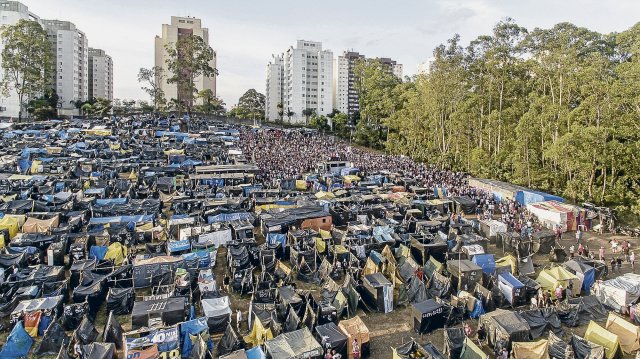Protest camp “Povo Sem Medo” in São Paulo, organized by the Movement of Homeless Workers (MTST), Brazil 2017–2018
Photo: Ninja Media, (CC BY-NC-SA 2.0)
How is political resistance built into physical space? Which constructions made of wood, metal, and fabric leave behind, help, perpetuate, and promote protests? An exhibition in the Vienna Museum of Applied Arts (MAK) takes on “Protest/Architecture,” and the subtitle “Barricades, Camps, Superglue” makes it clear that conceptually, as many varieties of political protest as possible can be brought under one roof or in one museum space want to bring: The body of a climate adhesive is just as much a part of the topic as the classic Paris Commune barricade, as are environmentalists’ shelters in the forest.
So if you ignore the permanent exhibition on the history of elegant interior design at the MAK and instead choose the “Protest/Architecture” curated by Oliver Elser from the German Architecture Museum Frankfurt am Main and Sebastian Hackenschmidt from the MAK, you will find yourself in front of a huge tarpaulin on which Among other things, a saw, a hammer, a pop-up tent, adhesive tape, a cordless screwdriver and a bicycle are placed. It is the “Lützerath wish list”, collected in the area around the MAK shortly before the evacuation of the protest camp last year, where hundreds tried to prevent the energy giant RWE from demolishing the hamlet of Lützerath and the village of Immerath in order to use the opencast mine there the nasty name Garzweiler II.
According to the exhibition text, a “toolbox of protest architecture” can be found here, and this proves that destructiveness does not have to be the primary motive in political protests, but creativity, cooperation and skill in dealing with resources are required when protest spreads in a space over the long term not in a Latsch demo.
Commented photo series and many, many elaborately designed miniatures of various small buildings that were built at the Technical University of Munich and the Stuttgart University of Applied Sciences illustrate various protests. The tree houses of the Hambach Forest hang from the ceiling, connected with delicate threads that hold bridges together. These fine models form a contrast to the heavy police uniforms, tailored to facilitate ruthlessness, that are placed right next to them.
One of the funniest exhibits is certainly the “Wendenpass”, which gave access to the Republic of Free Wendland, which was founded in 1980 by the anti-nuclear movement during the Gorleben protests. Anyone who suspects ahistorical imperial citizenship here is wrong, because the passport is valid “for the entire universe (…) as long as its holder can still laugh.” A little cheesy, but sweet.
Centrally placed is Oliver Hardt’s worthwhile video work “Protest/Architecture”, which shows different film footage of protests on different continents and from different decades: images of the demos from Tahrir Square in Egypt, the protests by Indian farmers in 2021, where tent cities were built, the Umbrella in Hong Kong from 2014 with its umbrella surfaces and many more. They are presented with information texts on crooked grid walls and the detailed miniature models already mentioned, which give an impression of how space is temporarily appropriated where and in what way.
During the Poor People’s Campaign Resurrection City, thousands of blacks and other Americans affected by poverty gathered in Washington D.C. – organized by Martin Luther King Jr. – and built a protest city out of prefabricated house building elements: Resurrection City. That is more impressive and more historically relevant than the first Viennese eco-pyramid in Lobau, where people resisted a social democratic highway project. However, both protest architectures are given roughly the same amount of space.
All sorts of legal questions about protest behavior (mistakes) are briefly and succinctly clarified on a table by lawyer Marcus Hohenecker. The fact that the above-mentioned German protests are being built upwards has something to do with the fact that, according to current police practice, special units have to arrive at a height of 2.50 meters, a “height intervention team”, which saves time: tree houses & co. as a “delay architecture”.
Even if the diversity of the protests, their respective urgency, and the political motives are not taken into account in the MAK exhibition, which is certainly not so nice for those involved in the more violent disputes, a visit is worth it in view of the exhibits, miniatures and the diversity of »Protest/Architecture«. Also recommended is the accompanying publication, an encyclopedia in which you can find all sorts of articles with topics ranging from 1830 to 2023, from A for “Abwurfen” to Z for “Zwentendorf” in Lower Austria, where there is a nuclear power plant that does not operate without protests could be taken.
»Protest/Architecture. Barricades, Camps, Superglue” until August 25th at the Museum of Applied Arts in Vienna.
judi bola sbobet sbobet88 sbobet
